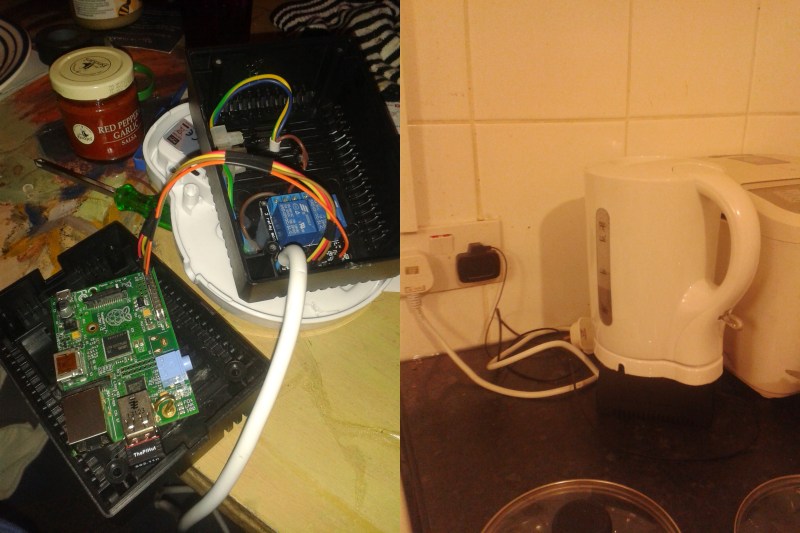Why do light bulbs, furnaces, outlets and even automated blinds get all the home automation love? Won’t somebody think of the kettle!? How are we suppose to ensure tea-time is always a button click away? Tired of his lack of options for remotely controlling his kettle, [FatCookies] decided to make his own WiFi enabled kettle.
He started by ripping up an old power supply enclosure he had lying around, and it happened to be just big enough for a Raspberry Pi. He then added a 2-way relay board designed for handling mains voltage at a high amperage — quite necessary for something that draws as much as a heating element.
From there it was just a matter of wiring the relay board to the GPIO on the Pi, and to the kettle itself. For safety reasons, he’s powered the kettle and the Pi separately — and don’t worry, he left the safety switch in the kettle intact.
And while we have to admit, it’s not the most aesthetically pleasing hack, it certainly does the trick — and didn’t cost [FatCookies] much at all.
But if you’re more of a coffee kind of person — you could also replicate this hack with a coffee maker instead.
[via r/DIY]
















Insert the mandatory “lame, you need to call your wife to tell her to fill it with water” comment.
Oh, right, HAD.
Replace ‘wife’ with ‘mother’.
I have a pump to do this dirty work
HTTP418
Damn, you beat me to it!
Lots of chatter at http://www.esp8266.com about this exact topic and methods to create it….
Richard j.
Unless you have the softest water on earth, the inside of the kettle will lime up and lose efficiency. The lime depositing is caused by the time spent boiling water. Also the lime and crap is concentrated in the water you drink the longer it boils.
Therefore it’s better to turn on the heater and wait the least amount of time for the water to just get near full boil and stop and use it. These heat rather fast when new. Some beverage use calls for hot not boiling water, some not.
Green use of appliances includes making them last as well using less power.
You can remove all the lime with some citric acid.
We’ve done this level of interactivity by plugging it in to a ZWave switch already. Now if he could control the physical switch, or possibly refill it…
I wouldnt be using that on a regular basis. Most domestic kettles in the uk are 3kW units (12A ish) which means the relay is under rated by 2 Amps.
was just about to say the same, those relays are a bit weedy considering the load. Most kettles make full use of the 13A outlet there connected too.
Yeah I normally assume that when wiring temporary catering feeds at events but just out of curiosity I went and metered it. I get 11.8A @ 246V AC on my old Fluke 77 meter. And yes I know 246v is high but living within 25 miles of 3 power stations will do that.
For pete’s sake, a rasperry pi just to turn the darn thing on? Come on! For that a ESP8266 and a relay would be enough, with a pi you should add touchscreen a shitload of relays and control the whole kitcthen, not to mention automate water into the kettle! Talk about overkill…
He should have done it with ESP8266 (smaller , cheaper…etc). ,Just saying
so he could burn the house down cheaper?
done some think similar with electric imp
https://www.youtube.com/watch?v=KJ1CCfSid2Y
something damn you auto-correct <.<
How much current did that ac draws?
Did something similar a while ago, same 10A relay + Esp8266 + USB charger, stuffed into a electrical box.
Using it for general purpose switching but wouldn’t use it for kettles though. Total cost about $6 + old USB charger I had laying around.
https://youtu.be/Gbr2gDwQgTE
It doesn’t support HTCPCP :(
I did something similar but I used the Etekcity Wireless Remote Control Outlet.
I have a blog post in Spanish http://blog.abeestrada.com/control-luz-wifi/
My A/C came with a remote